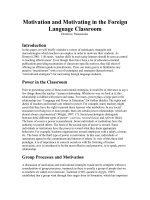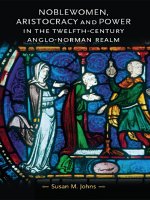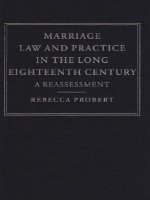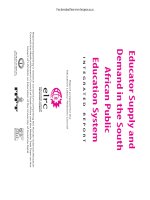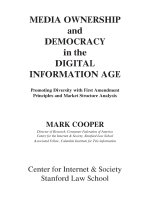workers and peasants in the modern middle east
Bạn đang xem bản rút gọn của tài liệu. Xem và tải ngay bản đầy đủ của tài liệu tại đây (1.48 MB, 225 trang )
Workers and Peasants in the Modern Middle East
The working people, who constitute the majority in any society, can be
and deserve to be subjects of history. Joel Beinin’s state-of-the-art survey
of subaltern history in the Middle East demonstrates lucidly and com-
pellingly how their lives, experiences, and culture can inform our histor-
ical understanding. Beginning in the middle of the eighteenth century,
the book charts the history of peasants, urban artisans, and modern
working classes across the lands of the Ottoman Empire and its Muslim-
majority successor-states, including the Balkans, Turkey, the Arab
Middle East, and North Africa. Inspired by the approach of the Indian
Subaltern Studies school, the book is the first to present a synthetic crit-
ical assessment of the scholarly work on the social history of this region
for the last twenty years. It offers new insights into the political, eco-
nomic, and social life of ordinary men and women and their apprehen-
sion of their own experiences. Students will find it rich in narrative
detail, and accessible and authoritative in presentation.
is Professor of Middle East History at Stanford
University. His publications include The Dispersion of Egyptian Jewry:
Culture, Politics, and the Formation of a Modern Diaspora (1998) and Wa s
the Red Flag Flying There? Marxist Politics and the Arab–Israeli Conflict in
Egypt and Israel,1948–65 (1990).
The Contemporary Middle East 2
Series editor: Eugene L. Rogan
Books published in The Contemporary Middle East series address the
major political, economic and social debates facing the region today.
Each title comprises a survey of the available literature against the
background of the author’s own critical interpretation which is
designed to challenge and encourage independent analysis. While the
focus of the series is the Middle East and North Africa, books are
presented as aspects of a rounded trea
tment, which cuts across
disciplinary and geographic boundaries. They are intended to initiate
debate in the classroom, and to foster understanding amongst
professionals and policy makers.
1 Clement M. Henry and Robert Springborg, Globalization and the
Politics of Development in the Middle East
Workers and Peasants in the
Modern Middle East
Joel Beinin
Stanford University
The Pitt Building, Trumpington Street, Cambridge, United Kingdom
The Edinburgh Building, Cambridge CB2 2RU, UK
40 West 20th Street, New York, NY 10011-4211, USA
10 Stamford Road, Oakleigh, VIC 3166, Australia
Ruiz de Alarcón 13, 28014 Madrid, Spain
Dock House, The Waterfront, Cape Town 8001, South Africa
© Cambridge University Press 2001
This book is in copyright. Subject to statutory exception
and to the provisions of relevant collective licensing agreements,
no reproduction of any part may take place without
the written permission of Cambridge University Press.
First published 2001
Printed in the United Kingdom at the University Press, Cambridge
Typeface Plantin 10/12 System QuarkXPress™ []
A catalogue record for this book is available from the British Library
Library of Congress Cataloguing in Publication data
Beinin, Joel, 1948–
Workers and peasants in the modern Middle East / Joel Beinin.
p. cm. – (The contemporary Middle East; 2)
Includes bibliographical references and index.
ISBN 0 521 62121 6 – ISBN 0 521 62903 9 (pbk.)
1. Working class – Middle East – History. 2. Artisans – Middle East – History.
3. Peasantry – Middle East – History. I. Title. II. Series.
HD8656.B44 2001
305.5′62′0956–dc21 00-068950
ISBN 0 521 62121 6 hardback
ISBN 0 521 62903 9 paperback
To the spirit of the Thälmann Battalion
and the Abraham Lincoln Brigade,
and those who carry it forward today
Contents
List of tables pag
e
viii
Acknowledgments ix
Glossary xi
List of acronyms and abbreviations xiv
Map 1 The Ottoman Empire, 1699–1914 xvi
Map 2 Egypt and Bilad al-Sham xvii
Map 3 The Middle East in the twentieth century xviii
Introduction 1
1 The world capitalist market, provincial regimes, and local
producers, 1750–1839 21
2 Ottoman reform and European imperialism, 1839–1907 44
3 The rise of mass politics, 1908–1939 71
4 Fikri al-Khuli’s journey to al-Mahalla al-Kubra 99
5 Populist nationalism, state-led development, and
authoritarian regimes, 1939–1973 114
6 Post-populist reformation of the w
orking class and peasantry 142
Notes 170
References 174
Index 199
vii
Tables
6.1 Turkish workers placed in positions abroad page 150
6.2 Arab labor migration 150
6.3 Strikes in Tunisia, 1970–77 155
6.4 Strikes in Turkey, 1963–94 161
viii
Acknowledgments
This book synthesizes and develops much of what I have offered in my
graduate colloquium on Economic and Social History of the Modern
Middle East for over a decade. The students I have had the privilege of
teaching in that class occupy a very special place in my heart. I have
enjoyed immensely learning from them and sharing their companionship
and sense of purpose.
Eugene Rogan and Marigold Acland first proposed to me that I write
this book and accompanied it through its completion. I am most grateful
that they did. The process of writing has forced me to think more broadly
and clarified many issues in my own mind.
In addition to them, Rob Blecher, Elliot Colla, Kenneth
Cuno,
Zachary Lockman, Karen Pfeifer, Marsha Pripstein Posusney, Nancy
Reynolds, and Shira Robinson read parts or all of the text at various
stages in its development. They offered many valuable comments and
saved me from some careless errors. Had I been able to implement
all their suggestions, this would undoubtedly have been a better
book.
Papers that evolved into chapter 4 were delivered in the spring of 1999
at the International Workshop on Modernity in the Middle East: History
and Discourse at Ben-Gurion University of the Negev; the Seminar on
Empires and Cultures Annual Workshop at Stanford University; and the
Conference on Nation and Cultural Perceptions of Identity at UCLA.
Early versions of chapter 6 were presented at the 1998 annual meeting of
the Middle East Studies Association and the Conference on New
Approaches to the Study of Ottoman and Arab Societies at Bog˘azıçı
University in 1999. An early version of small sections of chapters 5 and 6
was published as “The Working Class and Peasantry in the Middle East:
From Economic Nationalism to Neoliberalism,” Middle East Report no.
210 (Spring 1999):18–22.
A brief research trip to the Middle East in 1997 was supported by a
Hewlett Faculty Research Grant. Much of the text was written during
1999–2000 while I was a fellow at the Stanford Humanities Center – an
ix
extraordinary institution for which I wish much continued good fortune
and success.
This is the first book I have written without being in close contact with
its subjects. Nonetheless, some of them have always been in my mind and
heart. I can never repay the debt I owe to Fathi Kamil, Hasan Abd al-
Rahman, Muhammad Ali Amir, Muhmmad Jad, Muhammad Mutawalli
al-Sharawi, Atiyya al-Sirafi, and Taha Sad Uthman –
Egyptian workers
whose insights and memories of their own lives launched me on my aca-
demic career and who affirmed through their struggles and their kindness
to me the values we share.
As always, Miriam has supported me with her care and love.
x Acknowledgments
Glossary
aliya – wave of Zionist immigration to Palestine
amir or hakim – commander or prince, the hereditary ruler of Mount
Lebanon
ammiyya – commune, the name for peasant uprisings in nineteenth-
century Mount Lebanon and Hawran
aradi al-filaha or athar – lands on which peasants had usufruct rights in
Egypt
aradi al-usya – lands granted to the mamluks in Egypt
ayan (Tur.), a
yan (Ar.), also called derebeys, agˇas, or mütegallibes – provin-
cial notables or warlords who enhanced their power at the expense of
the central Ottoman state
bilad al-sham – greater Syria, including current-day Syria, Lebanon,
Jordan, Palestine, and Israel
boyars – local notables who became absentee landlords in Wallachia and
Moldavia
çift–hane system – the normative agrarian land-tenure system of the
Ottoman Empire. Each peasant household (hane) had the right to per-
petual tenancy on a farm (çift) large enough to sustain the family on
state-administered land as long as taxes were paid and cultivation
maintained
çiftlik – a farm, sometimes, but not always, a large, market-oriented estate
colon – a European settler in Algeria
dira – the collectively held tribal domain in North Arabia and lower Iraq
dunam/dunum – Palestine: 1 dunamϭ 0.23 acres; Iraq: 1 dunumϭ 0.618
acres
effendiyya – primarily an Egyptian term, the urban middle strata educated
in a western style and adopting European dress
esnaf (Tur.), tawa
if (Ar.) – urban guilds of artisans, merchants, and
service workers, rarely peasants
faddan – the standard Egyptian land measure, 1.03 acres
farda (Ar.), ferde (Tur.)– head tax imposed by the Egyptian regime during
the occupation of greater Syria in the 1830s
xi
gedik – originally, the tools necessary for a craft; subsequently, the right to
practice it
Hatt-ı S¸erif – 1839 Gülhane Edict, marking the onset of the Tanzimat
reforms
Histadrut – the General Federation of Hebrew Workers in (the Land of)
Israel established in 1920
hospodars – wealthy Greek merchants who ruled Wallachia and Moldavia
indirectly for the Ottoman state
ib
adiyya – a tax-free grant of uncultivated lands in mid-nineteenth
century Egypt
iltizam or muqata
a – tax farming or the plot of land itself
imara – the hereditary principality of Mount Lebanon
iqta
– the land-tenure and administrative system in Mount Lebanon,
often misleadingly translated as feudalism
irad-ı cedid – the fiscal apparatus established to finance the nizam-ı cedid
military unit
Islahat Fermanı – 1856 Reform Decree, the second of the major Tanzimat
measures
izba – an Egyptian estate where peasants were given a dwelling and land
to grow subsistence crops in exchange for labor service on the land-
lord’s cotton or other cash crops
Jabal Nablus – a district in the north of the central mountain chain of
Palestine
Janissary Corps – a musket-bearing infantry unit of the Ottoman army
jiflik – Arabization of çiftlik, an estate given to members of the royal family
in mid-nineteenth-century Egypt
kharajiyya – peasant lands defined by the 1854 Egyptian land law
malikâne – life-term tax farm
mamluk (Ar.), memlûk (Tur.) – an elite warrior-slave
mevat (Tur.), mawat (Ar.) – waste or uncultivated land
milk (Ar.), mülk (Tur.) – privately owned land
miri – state-administered land
mugharasa – a cultivation contract common in Mount Lebanon: an owner
would engage a peasant to plant trees on his land and cultivate them in
return for a portion of the land and the trees
mültezim (Tur.), multazim (Ar.) – holder of a tax farm
muqata
a – a district in the land-tenure and administrative system of Mount
Lebanon administered by a hereditary local notable, or muqata
aji
musha
a – collective form of landholding in Syria and Palestine
musharaka – sharecropping
mutamassirun – permanently resident Greeks, Italians, Armenians, Syrian
Christians, and Jews in Egypt
xii Glossary
mutanawwirun – in Syria, the term for the urban middle strata educated in
a western style and adopting European dress
nizam-ı cedid – the European-style military unit established by Sultan
Selim III (1789–1807)
Rumelia – the European parts of the Ottoman Empire
salam – a contract in which a merchant lends a peasant money and the
peasant agrees to deliver a harvest to the merchant in return for a spec-
ified price or portion of the proceeds from the sale of the crop
sarifa – a hut made from palm branches (Iraq)
sened-i ittifak – 1808 Document of Agreement confirming the powers of
the provincial notables
shari
a (Ar.), s¸eriat (Tur.) – Islamic law
Sipahis – Ottoman cavalry soldiers
sufi – a Muslim mystic. Mystical orders (turuq) were often mobilized for
political and social purposes
Tanzimat – mid-nineteenth-century elite-initiated legal, administrative,
and fiscal reforms of the Ottoman Empire
timar – a rural land holding used to support a sipahi and his retainers.
Larger holdings were called ziamet or hass.
tujjar – long-distance merchants of Cairo
uhda – a land grant to a military or civilian official in mid-nineteenth-
century Egypt
ulama
(Ar.), ülema (Tur.) – Muslim scholars
ushr (Ar.), ös¸ür (Tur.) – Ottoman land tax calculated as a percentage of a
crop, variable by region
ushuriyya – privileged estates (ib
adiyya, jiflik, and
uhda) according to
the 1854 Egyptian land law
vakıf (Tur.), waqf (Ar.) – a public or family endowment established in
accord with Islamic law
Wafd – the leading nationalist par
ty of interwar Egypt, named for the del-
egation formed to negotiate independence at the Versailles peace con-
ference
Glossary xiii
Acronyms and abbreviations
ASP – Arab Socialist Party (Syria)
ASU – Arab Socialist Union (Egypt)
AWC – Arab Workers’ Congress (Ittihad al-Ummal al-Arab, Palestine)
COLA – cost-of-living allowance
CPI – Communist Party of Iraq
CUP – Committee of Union and Progress (Ottoman Empire)
DI
˙
SK – Devrimi I
˙
s¸çi Sendikaları Konfederasyonu (Confederation of
Revolutionary Trade Unions, Turkey)
DMNL – al-Haraka al-Dimuqratiyya lil-Tahrir al-Watani (Democratic
Movement for National Liberation, Egypt)
DP – Democrat Party (Demokrat Partisi, Turkey)
EMNL – al-Haraka al-Misriyya lil-Tahrir al-Watani (Egyptian
Movement for National Liberation)
FATULS – Ittihad al-Niqabat wal-Jamiyyat al-Arabiyya (Federation of
Arab Trade Unions and Labor Societies, Palestine)
FLN – Front de Liberation Nationale (National Liberation Front,
Algeria)
GFETU – General Federation of Egyptian Trade Unions (al-Ittihad al-
Amm li-Niqabat Ummal Misr)
JNF – Jewish National Fund
JP – Justice Party (Adelet Partisi, Turkey)
LP – Labor Party (Egypt)
MI
˙
SK – Milliyetçi, I
˙
s¸çi Sendikaları Konfedarasyonu (Confederation of
Nationalist Workers’ Unions, Turkey)
MTWU – Niqabat Ummal al-Sanai al-Yadawiyya (Manual Trades
Workers’ Union, Egypt)
NCWS – al-Lajna al-Wataniyya lil-Ummal wal-Talaba (National
Committee of Workers and Students, Egypt)
NLL – Usbat al-Taharrur al-Watani (National Liberation League, Palestine)
PAWS – Jamiyyat al-Ummal al-Arabiyya al-Filastiniyya (Palestine Arab
Workers’ Society)
PCGFETU – al-Lajna al-Tahdiriyya lil-Ittihad al-Amm li-Niqabat Ummal
xiv
Misr (Preparatory Committee for a General Federation of Egyptian Trade
Unions)
PCP – Palestine Communist Party
PSD – Parti Socialist Destourien (Destourian Socialist Party, Tunisia)
RPP – Republican People’s Party (Cumhuriyet Halk Partisi, Turkey)
TLP – Türkiye I
˙
s¸çi Partisi (Turkish Labor Party)
Türk I
˙
s¸ – Türkiye I
˙
s¸çi Sendikaları Konfederasyonu (Confederation of
Turkish Trade Unions)
UAR – United Arab Republic
UGTA – Union Générale des Travailleurs Algériens (General Union of
Algerian Worker
s)
UGTT – Union Générale Tunisienne du Travail (General Union of
Tunisian Workers)
Acronyms and abbreviations xv
Ottoman from 1517;
British protectorate 1882–1922;
kingdom 1922
SPAIN
P
O
R
T
U
G
A
L
FRANCE
ALGERIA
MOROCCO
T
U
N
I
S
T
R
I
P
O
L
I
T
A
N
I
A
CYRENAICA
EGYPT
AUSTRIA
RUSSIA
ANATOLIA
CORSICA
SARDINIA
SICILY
I
T
A
L
Y
CRETE
CYPRUS
Filali dynasty from 1631;
French protectorate 1912–1956
Taken by France from
Ottoman Empire
1830;
independent 1962
Atlantic
Ocean
M
e
d
i
t
e
r
r
a
n
e
a
n
S
e
a
R
e
d
S
e
a
P
e
r
s
i
a
n
G
u
l
f
C
a
s
p
i
a
n
S
e
a
Black Sea
British colony
1878
Taken by France
from Ottoman Empire
1881;
independent 1956
Taken by Italy
from Ottoman Empire 1911;
allied control 1943–1950;
kingdom 1950
D
O
D
E
C
A
N
E
S
E
Nile
Volga
E
u
p
h
r
a
t
e
s
T
i
g
r
i
s
Ural
Dnieper
Dniester
The Ottoman Empire at its greatest extent
Ottoman territory 1912
Ceded by Ottoman Empire to Russia, with date
Ceded by Ottoman Empire to Austria, with date
Ceded by Ottoman Empire to Greece, with date
Date of cession
Independent of Ottoman Empire
Date of independence from Ottoman Empire
HUNGARY
BOSNIA
1878
1912
MONTENEGRO
1878
ALBANIA
1912
N.
SERBIA
1876
N. BULGARIA
1876
S. BULGARIA
1913
1699, 1718
JEDISAN
1792
PODOLIA
1699, 1793
CRIMEA
1783
B
E
S
S
A
R
A
B
I
A
1
8
1
2
Azov
1774
R
O
M
A
N
I
A
1
8
7
8
D
a
n
u
b
e
KARS
1878
K
A
B
A
R
D
I
A
1774
A
B
K
H
A
Z
I
A
1829
1878
1830
0
0
200 400 600 800 1000 1200 1400 1600 km
200 400 600 800 miles
GREECE
1830
THESSALY
1881
M
A
C
E
D
O
N
I
A
1913
Alexandria
Istanbul
Cairo
Jerusalem
Jaffa
Beirut
Damascus
Izmir
Ankara
Adana
Salonica
Tunis
Algiers
Oran
Constantine
Medina
KABYLIA
al-Mahalla al-Kubra
Homs
Hama
Aleppo
Mosul
Baghdad
Basra
Mecca
Kuwait
ÇUKUROVA
WALLACHIA
Seres
MOLDAVIA
Vidin
Yanina
Aral
Sea
Bursa
The Ottoman Empire, 1699–1914
Gaza
Jaffa
Acre
Al Arish
Cairo
Alexandria
Fayyum
Asyut
Girga
Nile
Jerusalem
Aleppo
Beirut
Damascus
Hama
Qina
al-Mahalla
al-Kubra
Nablus
Homs
Hebron
JABAL
DRUZE
R
e
d
S
e
a
Mediterranean
Sea
HAWRAN
MOUNT
LEBANON
SHUF
KISRAWAN
Dayr al-Qamar
AKKAR
AL-BALQA
Egypt and Bilad al-Sham
LIBYA
SAUDI
ARABIA
EGYPT
UNITED
ARAB
EMIRATES
IRAN
IRAQ
TURKEY
SYRIA
QATAR
KUWAIT
ISRAEL
LEBANON
GREECE
RUSSIA
Black Sea
ETHIOPIA
SOMALI REP.
DJIBOUTI
ALGERIA
MALI
NIGER
CHAD
NIGERIA
SUDAN
SPAIN
FRANCE
C
a
s
p
i
a
n
S
e
a
AZERBAIJAN
ARMENIA
ROMANIA
BULGARIA
ALBANIA
BURKINA
FASO
TURKMENISTAN
UZBEKISTAN
KAZAKSTAN
G
E
O
R
G
I
A
E
R
I
T
R
E
A
CYPRUS
M
A
U
R
I
T
A
N
I
A
M
O
R
O
C
C
O
T
U
N
I
S
I
A
P
O
R
T
U
G
A
L
I
T
A
L
Y
Y
E
M
E
N
O
M
A
N
MACE.
Y
U
G
O
S
L
A
V
I
A
B.H.
C
R
O
A
T
I
A
M
e
d
i
t
e
r
r
a
n
e
a
n
S
e
a
JORDAN
Tunis
Constantine
Algiers
Oran
Aleppo
Mosul
Istanbul
Baghdad
Homs
Hama
Damascus
Izmir
Ankara
Beirut
Basra
Mecca
Medina
Jerusalem
Tel Aviv
Aden
Khartoum
Alexandria
Cairo
al-Mahalla
al-Kubra
KABYLIA
Adana
Vidin
Salonica
Seres
Yanina
Asyut
Qina
Aswan
The Middle East in the Twentieth Century
Introduction
The working people who constitute the majority of any society can and
deserve to be historical subjects. Many aspects of their lives can not be rep-
resented by the methods typically deployed to write histor
ies of the politi-
cal activities and ideas of elites and lettered classes. Investigations into the
experiences and consciousnesses of working people cannot retrieve their
“true” voice and should not aspire to remake them into the universal sub-
jects of history. But such investigations can tell us many important things
about common people and their position in society
. Rethinking histor
ical
understandings from these premises can demarcate the limits of the
powers of states and other institutions of authority and discipline or the
ideas of elites and their organic intellectuals. It can also reveal relations of
hierarchy and power, processes by which they are established and main-
tained, and instabilities, tensions, and struggles within societies.
Until the late 1970s most histories of the Middle East took as their sub-
jects either the religious, legal, philosophical, and literary texts of Islamic
high culture or the political histories of states. Concentrating on such
topics virtually ensured that peasants, urban artisans, small merchants,
service workers, and slaves were peripheral to the main concerns of
“history.” The rare appearances of common people in historical writings
were usually refracted through the vision of elites or intellectuals close to
them, who had an interest in obscuring prevailing social hierarchies and
discourses of power.
Historians of Europe and the Americas dissatisfied with these limita-
tions developed a “new social history” that sought to give more promi-
nence to experiences and cultures of working people. They adopted
various methodological approaches: reinvigorated liberal, social demo-
cratic, or Marxian labor history, British cultural Marxism, French struc-
turalist Marxism, populist nationalism, peasant studies, feminism, ethnic
studies, etc. Just as it began to go out of fashion in European and
American studies, new social history made its way to Middle East studies
(Batatu 1978; Abrahamian 1982; Tucker 1985; Beinin & Lockman 1987;
Baer 1964; Baer 1969b; Baer 1982; Porath 1966).
1
1
Some new social historians assumed that class was a material reality
that ultimately determined all else. Until challenged by feminists, propo-
nents of ethnic studies, and others, they typically focused on white
working men in the public sphere and devoted inadequate attention to
race, gender, ethnicity, religion, generational difference, and sexual orien-
tation – categories often identified as “cultural” (Scott 1988). Writing
primarily about public struggles such as strikes or political campaigns
tended to obscure the activities of daily life in neighborhoods and fami-
lies, accommodation to structures of power, and weapons of the weak:
everyday forms of resistance that avoid direct confrontation and overt col-
lective defiance such as “foot dragg
ing, dissimulation, desertion, false
compliance, pilfering, feigned ignorance, slander, arson, sabotage” (Scott
1985: xvi). Many new social historians hoped that examining neglected
documentary evidence or reading previously known evidence against the
grain would allow them to retrieve the experiences of workers, peasants,
African slaves, women, ethnic minorities, etc., speak for them, and restore
them to the historical record. This often resulted in an act of ventrilo-
quism. Subordinate subjects were presented as saying what sympathetic
historians thought they would or should say.
This book seeks to synthesize some of the achievements of the new
social history and its legatees in Middle East studies and simultane-
ously to mitigate some of the limitations of these approaches by adopt-
ing the following propositions. Ideas and materialities do not constitute
an absolute dichotomy. They are mutually interpenetrable and interde-
pendent. The spheres of culture, politics, and economics are histori-
cally constructed and intertwined, but become relatively autonomous
forces once the ideas and social relations they configure win broad
acceptance. Classes, nations, modes of production, religious commu-
nities, gender identities, and other such categories are formed by an
amalgam of historical processes,
social relations, and discourses. They
are not objective entities independent of consciousness. They acquire
social force as people understand their experiences through them and
engage in debates over their “true” meaning. The actual beliefs and
practices of individuals who identify with or are identified as members
of any historically constituted group are unpredictable, though certain
combinations are observable historical patterns. Neither the working
class nor any other social group has a historical mission. I agree with
Salman Rushdie that “description is itself a political act” and “rede-
scribing a world is the necessary first step towards changing it”
(Rushdie 1991: 13, 14). It is possible, though not in any final and defin-
itive way, to describe a world. We need not be limited to analyzing texts
or representations of a world.
2 Workers and peasants in the modern Middle East
Workers, peasants, subalterns, classes
This book presents a synthetic narrative covering a broad geographical
and chronological range. Can there be a unified history of workers and
peasants whose lives were configured largely within highly diverse local-
ities, even if they were not nearly as isolated and self-sufficient as tradi-
tional conceptions commonly assert? According to Antonio Gramsci,
“the history of subaltern social groups is necessarily fragmented and epi-
sodic.” Gramsci offers a long list of topics that are formally external to the
subaltern strata, but which must be examined to approach an under-
standing of subaltern experience and consciousness (Gramsci 1971:
54–55). Several sections of this book adopt this method.
The term “subaltern” suggests that the subordinate social position of
artisans, workers, peasants, and other social groups – slaves, tribal
nomads, heterodox religious minorities, women – cannot be explained
solely by class relationships. I use it when seeking to emphasize other
aspects of social domination or the shared subordinate status of peas-
ants, artisans, and workers with others. Appropriating Gramsci’s termi-
nology, the Indian Subaltern Studies school proposes that histories of
these groups cannot be written either from the point of view of European
imperial powers or entirely in terms of the nationalist movements that
eventually arose in opposition to imperialism and established indepen-
dent states in the image of western Europe. Subalterns are typically only
incidentally and indirectly the subjects of archival records or cultural
productions of the lettered classes. This makes their experiences and
consciousnesses very difficult – some would argue impossible – to
retrieve (Spivak 1988).
This book owes a great conceptual debt to the ideas of the Subaltern
Studies school and those who have engaged with them. Can those inter-
ested in other parts of the world learn something from a history of the
Middle East informed by these ideas?
2
Several distinctive features of the
Middle East are of comparative interest. The economic, political, and
cultural ties of the Middle East with Europe are more substantial and
more long standing than is the case for any other part of the world. The
central Ottoman Empire was never subjected to colonial rule. It main-
tained its nominal independence until its demise, albeit over a shrinking
territorial base from the late seventeenth century on. Many develop-
ments commonly attributed to British colonial rule in India were
brought to the Middle East by elites of the Ottoman central government
or virtually independent provincial rulers. The settler colonial experi-
ences of Algeria and Palestine are distinctive. Useful comparisons have
been made between them and with the cases of South Africa and Ireland
Introduction 3
(Lustick 1993; Younis 2000). Other comparisons that consider the par-
ticularities of the Middle East are also possible. In most of the Middle
East, colonial rule arrived later and was briefer and weaker than in Latin
America, India, and parts of Africa. Muslims preserved a literate, high
cultural tradition that was both independent of European modernity and
in historical tension with Christianity. This may have enhanced the
capacity for cultural resistance to European imperialism in the Middle
East. Movements of politico-religious revivalism that arose in many parts
of the world in opposition to colonialism, imperialism, and the conse-
quences of Euro-American modernity appeared in the Middle East (and
some Muslim regions of Sudanic Africa) much earlier. Do these differ-
ences matter for the subaltern strata? Insofar as they are subordinated in
comparable ways, they may not. However, it is worth investigating
whether any relevant differences can be attributed to variations in
regional histories.
The category of social class is imbedded in a cer
tain way of under-
standing the history of Europe. It is common to write the history of the
Middle East and all of Asia, Africa, and Latin America against a stan-
dard established by the categories and processes of European history.
Many scholarly debates in Middle East history are concerned with when
and how successfully one or another part of the reg
ion entered on the
same historical trajectory as Europe and its white settler extensions.
This approach virtually ensures that the Middle East will be judged defi-
cient or inferior in comparison to Europe, and it obscures many com-
plexities and local specificities of the region that do not fit the European
model, which is often an idealized abstraction in any case. Nonetheless,
it must be acknowledged that certain ideas and institutions – the nation-
state, capitalism and its attendant social classes – which originated in
Europe spread to other parts of the globe and became a part of their
local histories.
I agree with Dipesh Chakrabarty that history as a category of knowl-
edge is, like economics, inseparable from the coerced imposition of mod-
ernity on non-Europeans in the colonial era and from the power of
colonial and post-colonial states (Chakrabarty 1992: 57). This is because
history is most commonly written using the records of moder
n structures
of domination, especially the nation-state. But precisely because the
concept of history and the institutions associated with it have become glo-
balized, those who were the subjects of Euro-American domination now
seek to empower themselves by, among other things, developing a sense
of their own historical identities. Histories of subaltern groups tend to
undermine the discursive power of states, social hierarchies, and national-
ist mystifications, and this book is offered in that spirit.
4 Workers and peasants in the modern Middle East
Where is the Middle East?
The mapping of politico-cultural zones is not an innocent process. It is a
modern technique of power that asserts the boundaries of sovereignty
and “civilization.” In this book the Middle East, with some qualifications,
refers to the territories of the Ottoman Empire and its successor states in
which Islam is the dominant cultural tradition. This definition privileges
a state and a religious tradition, though I do not essentialize either of them
and fully acknowledge the ethno-linguistic and religious diversity of the
region. Like any abstraction, this definition can be critiqued by local
empirical details, and I offer it provisionally.
Many definitions of the Middle East include Morocco and Iran, which,
though they never came under Ottoman rule, share much with the
Ottoman Empire and its successor states. Desert areas of contemporary
Algeria, Tunisia, Libya, and the Arabian Peninsula are on the margin of
this definition because of the weak Ottoman presence there, and they are
peripheral to this book because of the irregular character of agriculture
and the paucity of any stable group that might be designated as artisans or
workers. Sudan partially entered the Ottoman realm only in the nine-
teenth century. Israel is in the Middle East, but its ruling circles have
sought to ensure that it is not an integral part of the region culturally or
politically.
Focusing on regions that were once part of the Ottoman Empire some-
what artificially excludes regions – such as Iran and Morocco – that could
quite reasonably be included. I do so partly to enhance the coherence of the
narrative in this book and partly to emphasize that much of Europe was
politically, economically, and culturally connected to the region for hun-
dreds of years. That is to say that the boundary between Europe and its
others is not nearly as sharp and impermeable as it is often thought to be.
The Ottoman Empire, the longest continuous dynastic state in human
history, extended its rule from its Anatolian and Balkan heartland to
much of the Arabic- and Berber-speaking regions from 1516–17 until
World War I. Ottoman rule was not, as commonly portrayed by Arab
nationalists, an era of political oppression and economic stagnation for
Arabs, nor was it, as Islamists and Turkish nationalists assert, a golden
age. Muslims of many ethno-linguistic identities – Arabs, Berbers, Turks,
Kurds, Circassians, Abkhazians, Albanians, Bosnians, etc. – considered
Ottoman rule legitimate in Islamic terms. Christians and Jews found
secure and recognized places for themselves under the Ottoman
umbrella, though certainly not as citizens with equal rights – categories
which are equally anachronistic for both the Ottoman Empire and pre-
modern Europe.
Introduction 5
The territories comprising post-World War I Greece, Albania,
Macedonia, Serbia, Bosnia, Kossovo, Romania, Bulgaria, and other parts
of the Balkans were central components of the empire. These regions –
Rumelia, in Ottoman parlance – share with Anatolia and some of the pre-
dominantly Arab areas the lack of a landed aristocracy, a peasantry
relatively free from personal dependence and serfdom, and cities that
were fully integrated into the structure of state power, unlike medieval
western Europe (Todorova 1996: 60–61). Therefore, from the fourteenth
to the nineteenth centuries, it is reasonable to consider topics such as the
state of the peasantry, the landholding regimes, and urban guilds in the
Balkans in conjunction with those questions in Ana
tolia and the predom-
inantly Arab provinces of the empire. I do not do this as fully as possible
because of intellectual limitations shaped by training in area studies.
Despite their common Ottoman heritage and majority Muslim popula-
tions, it would be idiosyncratic, though not necessarily unfruitful, to con-
sider Albania and Iraq par
t of the same politico-cultural zone in the
twentieth century. The primary focus of attention in this book is Anatolia,
greater Syria (bilad al-sham), the Nile valley, the Tigris–Euphrates valley,
and the coasts of the Arabian Peninsula. Other regions are addressed
when it is analytically useful.
Orientalism and its critics
Traditional Orientalist scholarship argues that the Ottoman Empire, after
an exceptional period of fluorescence, began a period of protracted
decline in the late sixteenth century (Lewis 1961). In the 1950s this con-
ception was buttressed by the postulates of modernization theory, which
divides history into two periods: “tradition” and “modernity”(Lerner
1958). Scholarship guided by these conceptions viewed the eighteenth
century as a period of economic, political, and cultural stagnation in the
Middle East (Gibb & Bowen 1950). According to Orientalism and mod-
ernization theory, Napoleon’s invasion of Egypt in 1798 and its corollary,
Egypt’s occupation of greater Syria in the 1830s, marked a radical
rupture and initiated the modern era by providing the impetus for the
ideas of secularism, nationalism, and liberalism, the state system as we
know it today, economic development, and scientific and technological
progress (Safran 1961; Lewis 1961; Vatikiotis 1969 and subsequent edi-
tions; Polk 1963; Maoz 1968; Polk & Chambers 1968; Hourani 1962;
Shamir 1984).
Since the late 1970s, the Orientalist conception of Ottoman “decline”
and the dichotomy of “tradition” and “modernity” posited by modern-
ization theory have been largely discredited. Scholars inspired by rejec-
6 Workers and peasants in the modern Middle East
tion of Orientalism and modernization theory have established that at no
time was the Ottoman Empire or any of its component parts frozen in
timeless tradition. On the contrary, the years between 1600 and 1800
“were the point of departure for the modern experience” (Barbir 1996:
101).
Political economy
Edward Said’s denunciation of hostile and essentialist representations of
the Muslim world in the West, though it is the most widely known and
influential, is not the first or the most intellectually powerful critique of
Orientalism and modernization theory (Said 1978). Some scholars
working within the Orientalist tradition wrote economic and social histo-
ries that shed light on the experiences of ordinary people or demonstrated
that the normative prescriptions of Islamic texts were very broadly inter-
preted and did not constrain daily life in w
ays commonly imagined
(Rodinson 1978; Goitein 1967–93). Studies of political economy –
liberal, empirical versions and several varieties of neo-Marxism – argued
for a new periodization of the modern history of the region and focused
attention on the economic relations between Europe and the Middle East
and the connections betw
een economic exploitation and political domi-
nation (Chevallier 1968; Chevallier 1971; Owen 1969; Owen 1972;
Owen 1981a; Raymond 1973–74; Davis 1983).
One political economy school – world systems and dependency theory,
developed by Immanuel Wallerstein, Samir Amin, and others – was very
influential for a time. In opposition to the traditional Marxian focus on
relations of production, this approach argued that through relations of
circulation regions of the globe where capitalist production did not
prevail became peripheral parts of the world capitalist system as early as
the sixteenth century. Indeed, the development of industrial capitalism in
Europe and North America depended on unequal trade with the noncap-
italist world and forms of coerced labor such as slavery, indenture, or debt
peonage. Several of Wallerstein’s Turkish students brought a research
agenda inspired by his theory to Middle East studies (Wallerstein 1979;
Wallerstein & Kasaba 1983; Kasaba 1988; Islamogˇlu & Keyder 1987;
Keyder & Tabak 1991). World systems theory situates the Middle East in
relation to the emergent European center of the world capitalist economy.
The principal question posed in this conceptual framework is when the
region or some part of it was incorporated into the capitalist world
economy. While it directs attention away from the Ottoman state appara-
tus and Islamic high culture, world systems theory is ultimately
Eurocentric and teleological. It reduces complex local histories to a
Introduction 7
